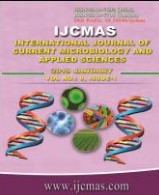


 National Academy of Agricultural Sciences (NAAS)
National Academy of Agricultural Sciences (NAAS)

|
PRINT ISSN : 2319-7692
Online ISSN : 2319-7706 Issues : 12 per year Publisher : Excellent Publishers Email : editorijcmas@gmail.com / submit@ijcmas.com Editor-in-chief: Dr.M.Prakash Index Copernicus ICV 2018: 95.39 NAAS RATING 2020: 5.38 |
India is the fourth largest oilseed producer in the world. Among the edible oilseed crops cultivated in India, mustard occupying the second position after groundnut sharing 27.5 per cent in Indian economy. It is also one of the important oilseed crops of Madhya Pradesh and is commonly grown in Sidhi district which falls in Kymore Plateau and Satpura Hills zone of the state. Krishi Vigyan Kendra, Sidhi conducted 64 technological frontline demonstrations to know the yield gap between improved package of practices (IP) and farmers practices (FP) under limited irrigation conditions. The study revealed that the mustard yield in improved practice ranged from 8.75 to 13.23 q/ha whereas in farmers practice it was in range of 6.70 to 10.09 q/ha. The technology demonstration on mustard registered highest yield (13.23 q/ha) which recorded in 2014-15 in which was 31.11 per cent higher over the farmer’s practice (10.09 q/ha). Extension gap and technology gap ranged between 1.87 to 3.60 and 2.95 to 11.43 q/ha respectively. The technology index ranged from 19.66 per cent to 57.15 per cent. The technology gap and index reflected farmer’s collaboration in carrying out the technology demonstrations with encouraging results in preceding years. The benefit cost ratio was estimated to be 2.15 to 3.64 under demonstration, while it ranged from 1.91 to 2.85 under farmer’s practice. The results indicated that these technology frontline demonstrations produced good impact on the farming community of the district as they were motivated by the technological interventions applied for considerably better production of mustard.
 |
 |
 |
 |
 |